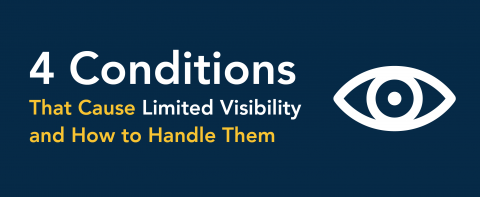
There are only two types of driving environments we can encounter, perfect and not so perfect. We use two terms to describe these environments: ideal and adverse. Visibility is something that refers to the ability to see and be seen. There are a number of conditions that can contribute to poor visibility while driving. Do you know how to safely address them?
What Causes Limited or Poor Visibility?
- Time of day. Too much sun or not enough sun can play tricks on the most experienced drivers. Combine rush hour with glaring sun and you’ve got a dangerous mix. The most dangerous time of day to drive is between 5:00 and 7:00 p.m.
- Weather conditions. Dicey weather conditions like heavy rain, snow or fog are less than optimal. All drivers, even novice drivers, quickly learn that they must be sensitive to deteriorating weather conditions. When confronted with adverse weather, determine if the trip is absolutely necessary or if it can be delayed.
- Direct obstructions to your view. From a dirty windshield/windows to overgrown vegetation along the roadway, all can block your view and line of sight, inhibiting your ability to see well.
- Poor roadway design. Abrupt roadway ramp exits and entrances or sharp turns on curves or hills contribute to limited visibility. One of the most important skills a driver can have is the ability to analyze the driving environment.
How to Address Obstacles to Your Visibility
- Scan ahead to anticipate potential hazards and turns. Don’t be forced into making an abrupt maneuver at the last moment! Remember, the average reaction time for drivers is 3⁄4 of a second. Allow yourself enough time to identify the hazard and a plan of avoidance.
- You should also adjust your speed to account for poor road conditions. Speed limits are posted for the ideal conditions, not adverse conditions.
- Be smooth and precise when braking, accelerating, and turning to avoid excessive weight transfer.
- Perform regular maintenance on your vehicle. Keep your windshield washer fluid reservoir full and ensure your headlights, wipers, and defroster are all operational.
- Increase following distance — there is no need to tailgate. Even if your vehicle is equipped with an anti-lock braking system (ABS brakes), you must still increase your following distance.
- Turn on low beams in the rain and/or snow. Using your low beams whenever you use your windshield wipers is required in Illinois.
- Always avoid driving impaired (drugs, alcohol, sleepy, etc.).
Helpful Acronym for Successful Driving (STV)
When matching or adjusting your speed for poor conditions or limited visibility, you must evaluate three key elements: space, traction and visibility (STV).
- Space quite literally refers to the area around the vehicle. Some examples of things that could affect our space would include: width of lanes, size of vehicles, debris in the roadway, parked vehicles, pedestrians, bicyclists, etc.
- Traction accounts for the grip of the tires to the road surface. Rain, snow tread wear, improper inflation, speed and road surface all affect tire traction.
- Visibility, as described earlier, pertains to what you can and cannot see around you.
Interested in taking an adverse weather course with Top Driver? Click here to register! This refresher course is only $15, online and self-paced.
